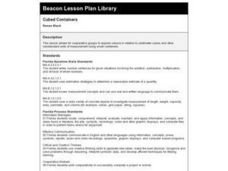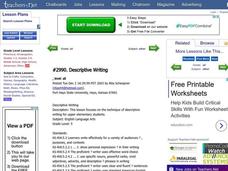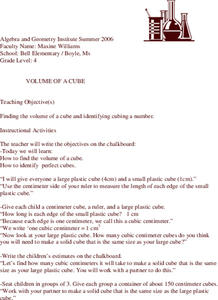American Chemical Society
What is Density?
Density: the reason a giant pumpkin will float, but a tiny cranberry won't. Lesson begins with a demonstration of two of the same-sized cubes having different densities. Then pupils take eight cubes, each of the same size, and have to...
Curated OER
Cubed Containers
Learners explore volume in relation to centimeter cubes and other nonstandard units of measurement using small containers. They will use hands-on materials to practice this concept. You will need small objects and containers to set this up.
Florida Center for Reading Research
Vocabulary: Word Meaning, Dictionary Cube
Scholars work together to define words and answer questions using a dictionary cube.
Curated OER
Scientific Method Experiment: Factors Affecting How Ice Melts
Students demonstrate the scientific method by conducting an ice cube melting experiment. They make predictions and observations, and conclude what factors make ice melt more slowly or quickly than normal.
Curated OER
Place Value: Hundreds, Tens, and Ones
Children arrange unit cubes, 10-rods, and 100-flats as indicated on the sheet. They write the appropriate digits in place value columns and the whole number on a line. Four practice opportunities plus a single multiple choice test prep...
Curated OER
Descriptive Writing
Students discuss the importance of using adjectives in writing. They separate into five groups, each group is given a bag with an object inside to describe using just one sense. They write a description of a Hershey's Kiss using adjectives.
Curated OER
Volume Of A Cube
Fourth graders find the volume of cubes and cylinders. To determine volume, they fill large cubes with centimeter cubes. They discuss the formula used to find the volume of a cube. Students explore why the solution to the volume of a...
Concord Consortium
The Six Faces of Amzora
Here's a task that is out of this world! Given a description of a fictional cube-shaped planet, scholars answer a set of questions about the planet. They create a two-dimensional map and consider the distances between locations on the map.
Pyro Innovations
Get into Shape
Shapes are so fun! Little ones explore, identify, and create shapes using tangrams or pattern blocks. The activity is intended to stimulate critical thinking while engaging learners through play and shape identification. Each child will...
Curriculum Corner
Bugs and Flowers Math and Literacy Centers
The sun shines, flowers bloom, and bugs fly—it must be Spring! Add a cheerful theme of bugs and flowers to math and literacy centers. Scholars take part in an assortment of activities designed to reinforce concepts such as...
Virginia Department of Education
Translate and Evaluate
Translate, evaluate, educate. Discover how to translate and evaluate expressions. Young mathematicians first review words and phrases that indicate operations and learn to write algebraic expressions from verbal descriptions....
Curated OER
Surface area of a cube
In this surface area of a cube worksheet, students answer short answer questions on how to find the surface area and calculating the equation for different problems. Students answer 7 questions.
Curated OER
Cubes, Sums and a Little Fun
First graders, with partners, create and solve math problems using number and unifix cubes.
Curated OER
Multiplication Strategies and Writing Story Problems
Third graders model multiplication problems using Unifix cubes. They compute and solve problems involving addition and subtraction of 3- and 4- digit numbers and basic facts of multiplication and division. They practice mental math...
Curated OER
Revise Identifying 3-D Shapes
In this 3-D shapes worksheet, students practice identifying 8 3-D shapes with their following precise names: cube, cuboid, square based pyramid, cone, cylinder, tetrahedron, octagonal prism and hexagonal prism.
Curated OER
Greek Mythology Character Cubes
Pupils research Greek myths and identify characters from ancient Greece. After discussing the names, descriptions, scenes an objects in Greek mythology, they draw pictures on tiles and write descriptions. Students join the tiles together...
Civil War Trust
Contrasting the North and South before the War
Learners create a standing cube with four panels that display information on the North and South's economy, geography and climate, society, and means of transportation before the Civil War. Through discussion and reading...
American Battlefield Trust
Contrasting the North and South Before the War
Fundamental differences between the North and South led to the South adopting a system of enslaved labor. These abstract ideas become concrete when class members create a standing cube using information provided in the resource. Young...
Concord Consortium
Swimming Pool II
Combine geometry and algebra concepts to solve a modeling problem. Young scholars consider the effect surface area has on volume. They write a cubic function to model the possible volume given a specific surface area and then...
Curated OER
Unit Cubes
In this unit cube worksheet, students solve 3 different problems that contain various parts to each of them. First, they write as many 3-digit numbers as they can given the numbers 2, 3, 5, and 7. Then, students count how many unit cubes...
Curated OER
Complete the Addition Fact Using Cubes
In this addition with cubes worksheet, learners count the cubes, and write the addends and sum to solve the addition problem.
Curated OER
Paper Folding to Make Cubes
Examine patterns of figures composed of six-squares and predict which of the twenty presented could be folded to make a cube. They then fold large-scale patterns of these figures to confirm their hunches.
Novelinks
The Book Thief: Cubing Strategy
Whether used to review prior to a reading assessment or as a way to generate ideas for an essay, this activity is sure to encourage critical thinking about Markus Zusak's The Book Thief. Kids create a six-sided question cube with each...
Curated OER
Countdown Challenge: Platonic Solids - Part I
Use a Platonic solids learning exercise to record the number of faces, edges, and vertices of five polyhedra whose faces, edges, and vertices are all identical. For each figure, learners write a proof of Euler's formula (F+V=E+2). They...

























